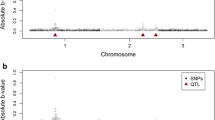Abstract
Selective genotyping is the marker assay of only the more extreme phenotypes for a quantitative trait and is intended to increase the efficiency of quantitative trait loci (QTL) mapping. We show that selective genotyping can bias estimates of the recombination frequency between linked QTLs — upwardly when QTLs are in repulsion phase, and downwardly when QTLs are in coupling phase. We examined these biases under simple models involving two QTLs segregating in a backcross or F2 population, using both analytical models and computer simulations. We found that bias is a function of the proportion selected, the magnitude of QTL effects, distance between QTLs and the dominance of QTLs. Selective genotyping thus may decrease the power of mapping multiple linked QTLs and bias the construction of a marker map. We suggest a large proportion than previously suggested (50%) or the entire population be genotyped if linked QTLs of large effects (explain > 10% phenotypic variance) are evident. New models need to be developed to explicitly incorporate selection into QTL map construction.
Similar content being viewed by others
References
Bradshaw HD Jr, Wilbert SM, Otto KG, Schemske DW (1995) Genetic mapping of floral traits associated with reproductive isolation in monkeyflowers (Mimulus). Nature 376:762–765
Darvasi A, Soller M (1992) Selective genotyping for determination of linkage between a marker locus and a quantitative trait locus. Theor Appl Genet 85:353–359
Darvasi A, Soller M (1994) Selective DNA pooling for determination of linkage between a molecular marker and a quantitative trait locus. Genetics 138:1365–1373
Darvasi A, Weinreb A, Minke V, Weller JI, Soller M (1993) Detecting marker-QTL linkage and estimating QTL gene effect and map location using a saturated genetic map. Genetics 134:943–951
Doebley J, Stec A (1991) Genetic analysis of the morphological differences between maize and teosinte. Genetics 129:285–295
Doebley J, Stec A (1993) Inheritance of the morphological differences between maize and teosinte: comparison of results for two F2 populations. Genetics 134:559–570
Dudly JW (1993) Molecular markers in plant improvement: manipulation of genes affecting quantitative traits. Crop Sci 33:660–668
Edwards MD, Stuber CW, Wendel JF (1987) Molecular-markerfacilitated investigation of quantitative-trait loci in maize. I. Numbers, genomic distribution and types of gene action. Genetics 116:113–125
Falconer DS (1989) Introduction to quantitative genetics, 3rd edn. Longman, New York
Fisher RA (1941) Average excess and average effect of a gene substitution. Ann Eugen 11:53–63
Groover A, Devey M, Fiddler T, Lee J, Megraw R, Mitchell-Olds T, Sherman B, Williams C, Neale D (1994) Identification of quantitative trait loci influencing wood specific gravity in an outbred pedigree of loblolly pine. Genetics 138:1293–1300
Jiang C, Zeng Z-B (1995) Multiple trait analysis of genetic mapping for quantitative trait loci. Genetics 140:1111–1127
Lander ES, Botstein D (1989) Mapping Mendelian factors underlying quantitative traits using RFLP linkage maps. Genetics 121:185–199
Mitchell-Olds T (1995) The molecular basis of quantitative genetic variation in natural populations. Trends Ecol Evol 10:324–328
Lin J-Z, Ritland K (1996) Construction of a genetic linkage map in the wild plant Mimulus using RAPD and isozyme markers. Genome 39:63–70
Paterson AH, Lander ES, Hewitt JD, Paterson S, Lincoln SE, et al. (1988) Resolution of quantitative traits into Mendelian factors by using a complete linkage map of restriction fragment length polymorphisms. Nature 335:721–726
Soller M, Genizi A (1978) The efficiency of experimental designs for the detection of linkage between a marker locus and a locus affecting a quantitative trait in segregating populations. Biometrics 34:47–55
Soller M, Genizi A, Brody T (1976) On the power of experimental designs for the detection of linkage between marker loci and quantitative loci in crosses between inbred lines. Theor Appl Genet 47:35–39
Stuber CW, Lincoln SE, Wolff DW, Helentjaris T, Lander ES (1992) Identification of genetic factors contributing to heterosis in a hybrid from two elite maize inbred lines using molecular markers. Genetics 132:823–839
Tanksley SD (1993) Mapping polygenes. Annu Rev Genet 27:205–233
Zeng Z-B (1993) Theoretical basis of separation of multiple linked gene effects on mapping quantitative trait loci. Proc Natl Acad Sci USA 90:10972–10976
Zeng Z-B (1994) Precision mapping of quantitative trait loci. Genetics 136:1457–1468
Author information
Authors and Affiliations
Additional information
Communicated by G. Wenzel
Rights and permissions
About this article
Cite this article
Lin, J.Z., Ritland, K. The effects of selective genotyping on estimates of proportion of recombination between linked quantitative trait loci. Theoret. Appl. Genetics 93, 1261–1266 (1996). https://doi.org/10.1007/BF00223458
Received:
Accepted:
Issue Date:
DOI: https://doi.org/10.1007/BF00223458




